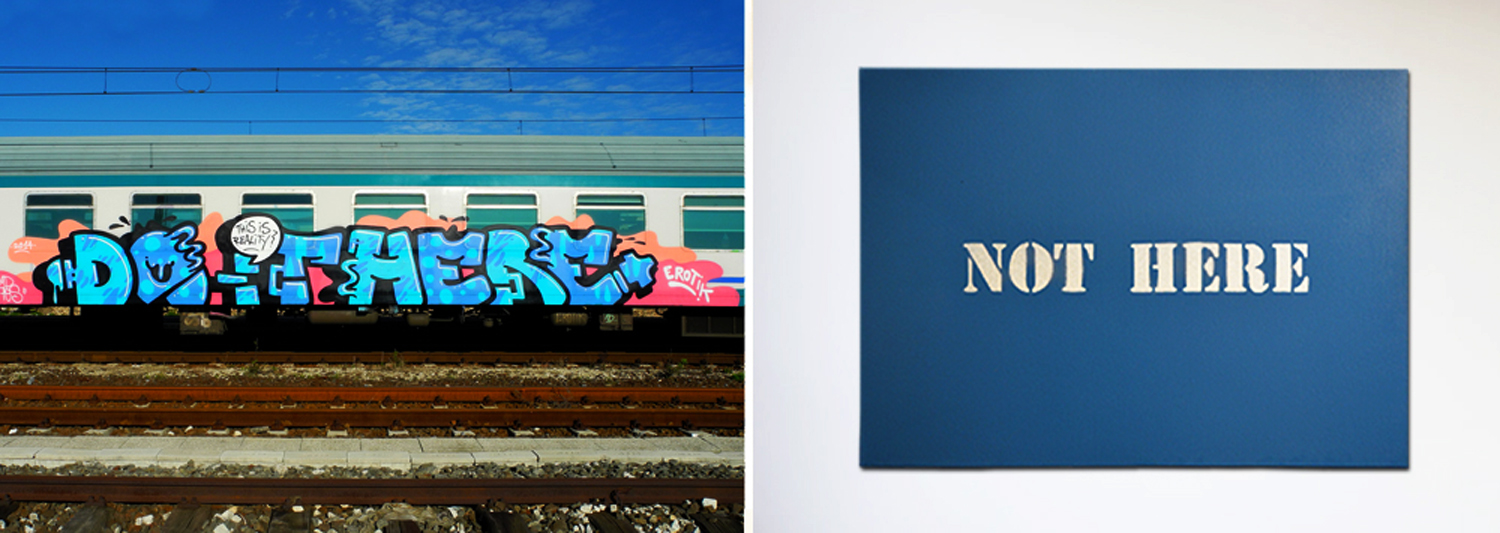We’ve been fascinated by the conceptual work of the self-described “Urban Activist” Fra. Biancoshock recently. He appears to be in the midst of distilling some of the fundamental arguments of the street art scene, from a provocative perspective of course. His earnest examination of these arguments sheds a light on their nature and provides a spark for further discussions.
A few weeks ago he stenciled the word “Toy” across a graffiti piece in the urban wild, and the genuine act contained the obvious insult as well as a meditation on its many implications about “rules” and history of the game. By committing the act of dissing purely as an academic exercise, he took us one step back from a simple act of rivalry to consider what it means to call someone a toy and to use a stencil to do it with.
Today he creates a piece for the viewer to consider another contested debate; Where does graffiti rightly belong, assuming it belongs anywhere? More to the point, is it correct to call a piece of work “graffiti” if it is made specifically to be hung in a gallery? Stripped of its illicit nature, is it actually graffiti when it is in the gallery? Further complicating the discussion, he uses a stencil for the inside piece, a technique many graffiti artists wouldn’t consider graffiti.
Erotik . Fra Biancoshock. “Do It Here” CLICK ON IMAGE TO ENLARGE (Photo courtesy of © Fra Biancoshock)
For Fra. Biancoshock’s new project, in which he collaborated with one of the historically well known and celebrated Italian graffiti writers, Erotik, he fairly decisively tells us his opinion on definition and gives a pretty straightforward directive. Perhaps he is advocating that graffiti and street artists not show their work as fine art in a gallery setting at all.
“This is a provocative project that underlines the importance of clarifying what graffiti is, where it were born, and where is the natural place to create it,” he says. “The phrase is simple and immediate. Similarly the concept is simple: Do graffiti in the street, illegally, without sponsors, not on the canvases for exhibition spaces,” he says. In other words, you cannot make a work for the gallery and call it graffiti, and that is not where it belongs.
We think that’s what it means anyway.
Other Articles You May Like from BSA:
Don't miss this cool auction of work by many of today's Street Artists on the New York scene, and some other folks you might have heard of! Young New Yorkers works with 16 and 17 year-old kids who ha...
Graff, street art, and skate worlds have always overlapped and when it comes to gear and fashion, the street influences all of them. Now it's a vernacular. We like to look at new products; actuall...
In the realm where imagination dances with audacity, Yok & Sheryo, the dynamic duo hailing from the crossroads of New York, Australia, and Asia, have conjured up a whimsical masterpiece, aptly ti...
Sweden’s northernmost town center is in Kiruna, with a population of 23,000 or so, is far north of Swedish Lapland. Known for mining iron ore and landing inside the Artic Circle on the eastern shore ...
Our weekly focus on the moving image and art in the streets. And other oddities. Now screening : 1. Back to Skool with Professor Sofles BSA Special Feature: Back to Skool with Professor So...
 BROOKLYN STREET ART LOVES YOU MORE EVERY DAY
BROOKLYN STREET ART LOVES YOU MORE EVERY DAY












